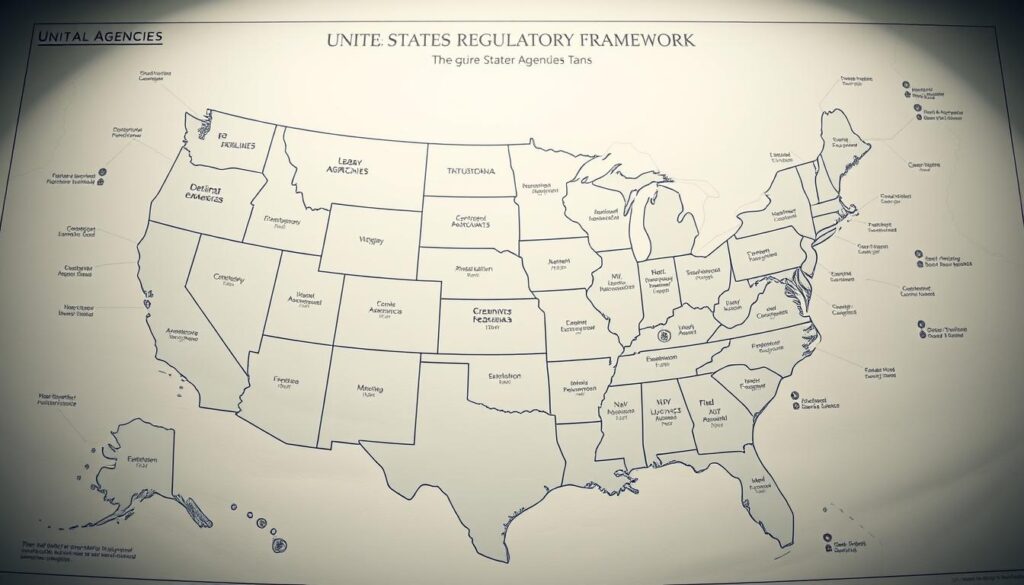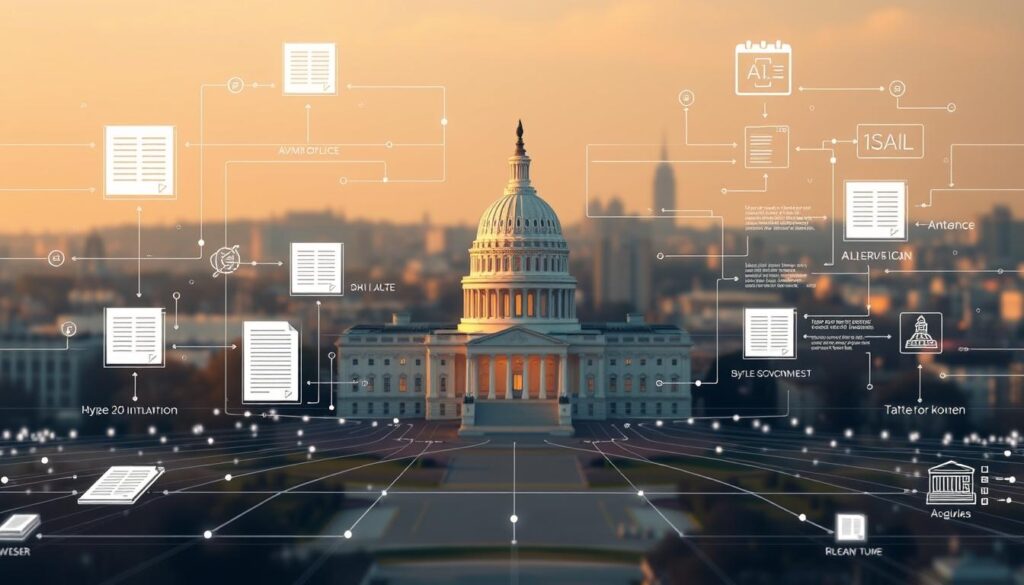What happens when groundbreaking technology evolves faster than the rules meant to govern it? This question lies at the heart of today’s debate over balancing innovation with accountability in artificial intelligence systems. As nations grapple with unprecedented challenges, the United States faces a unique crossroads—operating without unified federal laws while navigating shifting priorities between administrations.
The current regulatory framework resembles a mosaic of executive actions and state-level experiments. Recent policy reversals, including the replacement of the Biden administration’s guidelines with a more industry-focused approach, highlight the volatility shaping technological governance. This instability creates opportunities for rapid advancement but raises critical questions about consistency in addressing algorithmic transparency and societal impacts.
Businesses and researchers now navigate a labyrinth of voluntary standards and evolving expectations. While federal lawmakers debate proposals emphasizing responsible AI practices, states like California and Illinois have pioneered their own regulations targeting bias mitigation and data privacy. This fragmented landscape underscores the tension between fostering competitiveness and ensuring ethical safeguards.
Key Takeaways
- No comprehensive federal laws exist for AI oversight—guidance comes from executive orders and state initiatives
- Recent policy shifts prioritize industry growth over previous administration’s risk-management frameworks
- Private sector self-regulation plays an increasing role amid legislative delays
- International standards influence U.S. corporate strategies despite domestic policy gaps
- Decisions today will shape economic leadership and civil liberties for decades
Introduction to AI Ethics Legislation

As automated decision-making reshapes industries from banking to healthcare, policymakers face a pressing challenge: creating guardrails for technologies that learn faster than laws can adapt. Nearly 1 in 4 American companies now use artificial systems for critical operations, with adoption rates doubling annually since 2020.
| Sector | Key Challenges | Regulatory Focus |
|---|---|---|
| Healthcare | Diagnostic accuracy | Clinical validation |
| Finance | Credit fairness | Bias detection |
| Criminal Justice | Sentencing disparities | Transparency mandates |
New ethical frameworks aim to balance innovation with accountability. Developers must now document decision pathways in machine learning tools, creating audit trails for high-stakes applications. California’s recent transparency act requires impact assessments for housing and employment algorithms.
The complexity stems from competing priorities. While tech leaders advocate for flexible guidelines, civil groups demand strict oversight mechanisms. This tension surfaces most acutely in healthcare, where diagnostic algorithms require both innovation speed and clinical rigor.
Emerging governance models emphasize collaborative development. Cross-industry consortia now shape standards for testing protocols and error reporting. These efforts seek to maintain U.S. technological leadership while addressing societal concerns about automated decision-making.
Historical Context and Evolution of AI Policies

Decades of innovation set the stage for today’s complex debates over intelligent systems. Initial government engagement prioritized scientific breakthroughs over regulatory frameworks, viewing technological supremacy as critical to national competitiveness.
Early Regulatory Efforts and Policy Milestones
The National Artificial Intelligence Initiative Act of 2020 marked Washington’s first coordinated effort to accelerate research across federal agencies. This legislation channeled resources into machine learning advancements while cautiously acknowledging accountability concerns. Earlier initiatives focused narrowly on maintaining U.S. leadership against global rivals like China.
Transition from R&D Focus to Governance
By 2022, congressional hearings began addressing algorithmic discrimination in housing and hiring. This shift reflected growing recognition that pure development incentives couldn’t resolve emerging societal challenges. Federal advisory boards started proposing evaluation standards for facial recognition and predictive policing tools.
New approaches emerged through partnerships between tech firms and civil rights organizations. These collaborations informed early technical benchmarks for bias detection—a precursor to today’s emerging governance models. The evolution demonstrates how intelligence policy gradually incorporated ethical considerations without stifling innovation.
Current Regulatory Framework in the United States

The United States’ approach to governing emerging technologies reveals a patchwork of policies struggling to keep pace. Unlike the European Union’s unified artificial intelligence law, American oversight operates through overlapping state mandates and revised sectoral regulations.
Federal agencies adapt century-old statutes to manage modern systems. The FTC enforces fairness standards using 1914 consumer protection laws, while the FDA applies medical device rules to diagnostic algorithms. This retroactive framework creates inconsistencies across industries:
| Jurisdiction | Focus Area | Key Mechanism |
|---|---|---|
| Federal | Healthcare Algorithms | FDA premarket approval |
| State | Employment Screening | Illinois AI Video Interview Act |
| Local | Predictive Policing | New York City Algorithmic Accountability |
California leads in consumer protections, requiring impact assessments for automated decision-making under its revised Privacy Act. “We’re building plane parts mid-flight,” notes a Brookings Institution analyst, highlighting the challenge of regulating evolving systems.
This fragmented approach particularly affects AI in financial services, where lenders balance federal fair lending laws with state-specific transparency mandates. Companies now allocate 15-20% of compliance budgets to navigate conflicting requirements.
Without comprehensive federal law, businesses face mounting operational complexity. Cross-state data sharing agreements and voluntary certification programs attempt to bridge gaps, but critics argue these measures lack enforcement teeth.
Key Federal Legislation and Executive Orders

The landscape of U.S. tech governance shifts dramatically with each administration’s priorities. Federal directives attempt to steer artificial intelligence development while balancing innovation and public safeguards. These efforts create a regulatory pendulum that swings between oversight and market freedom.
National Artificial Intelligence Initiative Acts and Guidelines
The 2020 National Artificial Intelligence Initiative established research coordination across 15 agencies. It prioritized funding for machine learning advancements in defense and healthcare. Though not a comprehensive law, this initiative shaped later policy frameworks through its focus on workforce training and international collaboration.
Impact of Shifting Administrative Policies
Recent executive orders reveal stark contrasts in governance approaches. The 2023 Biden order mandated safety testing for high-risk systems used in critical infrastructure. It required bias audits for employment algorithms – provisions revoked in 2025 when new leadership prioritized development use acceleration.
| Executive Order | Focus Area | Key Features |
|---|---|---|
| Biden 2023 | Safety Protocols | Pre-deployment testing, transparency reports |
| Trump 2025 | Market Growth | Reduced compliance burdens, R&D tax incentives |
| Biden 2025 (Retained) | Cybersecurity | Critical infrastructure protection standards |
These reversals leave companies navigating conflicting requirements. A tech compliance officer notes: “We redesign systems every 18 months to match new federal expectations.” Surviving provisions like cybersecurity rules demonstrate areas of bipartisan agreement.
The instability underscores the need for legislative solutions beyond temporary policy shifts. As global competitors solidify their governance frameworks, U.S. leadership in intelligence systems faces both opportunities and risks from this regulatory volatility.
The Role of States in Shaping AI Legislation

State governments now drive tangible progress in governing advanced technologies. With federal standards lagging, regional lawmakers craft solutions addressing local industry needs and public concerns. This decentralized approach creates diverse regulatory environments where systems deployment faces varying oversight based on geography.
Innovative State-Level AI Acts
Colorado’s 2024 legislation introduced a tiered framework for high-risk applications, requiring impact assessments for hiring tools and healthcare diagnostics. The law mirrors European risk classifications while allowing flexibility for emerging technology. California expanded its mandates in 2025, mandating watermarking for synthetic media and disclosure protocols for entertainment industry contracts.
Illinois took a specialized approach through judicial reforms. Its Supreme Court policy mandates human review for sentencing recommendations generated by automated systems. “Tools should enhance fairness, not obscure accountability,” states the policy document, reflecting growing emphasis on transparency in public sector use.
Coordination Between State and Federal Efforts
Diverging priorities create friction between regional and national strategies. While federal agencies promote voluntary standards for financial sector compliance, states like New York enforce strict audit requirements. This patchwork increases operational costs for companies operating across multiple jurisdictions.
Emerging models suggest potential alignment pathways. Thirteen states now participate in a shared certification program for recruitment algorithms, reducing redundant testing. Such initiatives demonstrate how localized experiments could inform broader governance frameworks while preserving regional autonomy.
AI Ethics Legislation: Core Principles and Challenges
Balancing innovation with societal safeguards forms the crux of modern technological governance debates. The White House Blueprint for an AI Bill of Rights outlines five foundational pillars, emphasizing equitable access and protection against algorithmic harm. These guidelines attempt to reconcile rapid technological advancement with enduring democratic values.
“Automated systems should advance equity, not undermine it.”
Central to ethical frameworks is the concept of algorithmic accountability. Traditional liability models struggle with systems where decisions emerge from opaque data interactions. For instance, mortgage approval tools trained on historical data often perpetuate past biases despite anti-discrimination laws.
| Principle | Implementation Challenge | Industry Example |
|---|---|---|
| Safe Systems | Technical Complexity | Autonomous vehicle testing protocols |
| Algorithmic Non-Discrimination | Bias Detection | Healthcare diagnostic tools |
| Human Alternatives | Cost-Benefit Analysis | Customer service chatbots |
Translating principles into practice requires addressing three key hurdles. First, technical standards for bias measurement lack consensus—a challenge highlighted in international responsible practices. Second, enforcement mechanisms must adapt to systems that evolve through continuous learning. Third, smaller developers often lack resources for compliance audits, risking market consolidation.
Emerging solutions focus on collaborative governance. Cross-sector partnerships are developing testable benchmarks for fairness in hiring algorithms. Meanwhile, states like Colorado mandate impact assessments for high-risk tools—an approach gaining traction nationwide. These efforts align with global initiatives addressing ethical challenges in autonomous systems.
The path forward demands balancing innovation speed with protective measures. As one policy analyst notes: “We’re not just coding software—we’re encoding societal values.” This reality underscores the need for adaptive frameworks that maintain public trust without stifling progress.
Global Perspectives and International Influences on AI Policy
From Brussels to Beijing, policymakers are rewriting rulebooks for the age of autonomous decision-making. Nations now compete to establish governance frameworks that reflect their cultural priorities and economic ambitions. This global patchwork of artificial intelligence policies reveals fundamental divides in how societies balance innovation with control.
Comparative Analysis of Regulatory Frameworks
The European Union’s comprehensive AI Act sets a precedent for risk-based regulation. It bans certain applications like social scoring while requiring strict compliance protocols for high-risk systems. “Our goal is human-centric innovation,” states an EU policy document, emphasizing transparency in public sector deployments.
China’s Interim Measures take a different path, focusing on state oversight of generative systems. The rules mandate real-name verification for users and strict content moderation—prioritizing social stability over individual privacy. This approach aligns with broader information control strategies in sensitive sectors.
| Region | Focus | Key Mechanism |
|---|---|---|
| EU | Rights Protection | Prohibited Practices List |
| China | Content Governance | Generative AI Licensing |
| OECD | Global Standards | Voluntary Principles |
Multilateral organizations bridge these divergent approaches. The ISO’s technical standards help companies navigate compliance across borders, while the OECD’s principles guide national policymakers. These efforts create soft-law pathways in a world lacking unified regulations.
For U.S. enterprises, this landscape demands strategic adaptation. Firms operating globally must reconcile Europe’s strict accountability rules with Asia’s emphasis on data localization. As one tech executive notes: “We design systems that can toggle between regulatory environments.” This flexibility becomes crucial in maintaining competitiveness across international markets.
Sector-Specific AI Regulations and Compliance
Industry-specific governance models reveal how regulators balance innovation with public protection. Three sectors demonstrate distinct approaches to managing automated systems: healthcare diagnostics, financial risk assessment, and judicial decision support. Each faces unique challenges in aligning technical capabilities with sector-specific regulations.
Healthcare: Precision vs. Accountability
Medical diagnostic tools require rigorous validation under FDA guidelines. Developers must demonstrate clinical accuracy while maintaining audit trails for algorithmic decisions. Recent updates to the proposed Artificial Intelligence and Data Act highlight evolving standards for bias mitigation in patient triage systems.
Finance: Transparency in Credit Systems
Lenders using predictive algorithms now face dual mandates. Federal fair lending laws intersect with state-level transparency rules. Institutions must document how data inputs affect credit scores—a requirement expanding under cross-border agreements like Canada’s risk-tiered framework.
Judicial Applications: Human Oversight
Courts increasingly demand explainability for sentencing recommendation tools. Illinois mandates human review of algorithmic outputs, ensuring final decisions align with legal precedents. This approach balances efficiency gains with constitutional safeguards.
Compliance costs vary significantly across sectors. Financial institutions spend 18% more on security protocols than healthcare providers, reflecting differing use cases for sensitive data. As noted in recent financial sector compliance reports, adaptive frameworks remain critical for maintaining public trust in automated systems.







